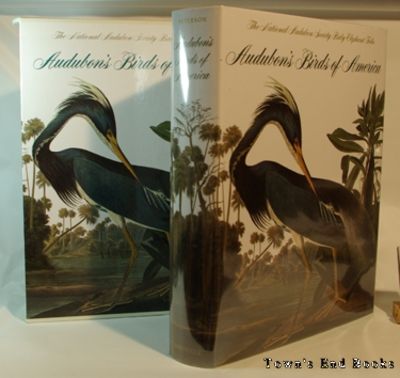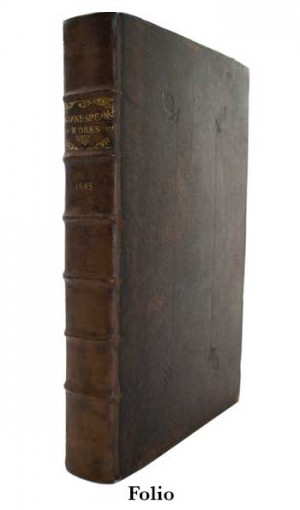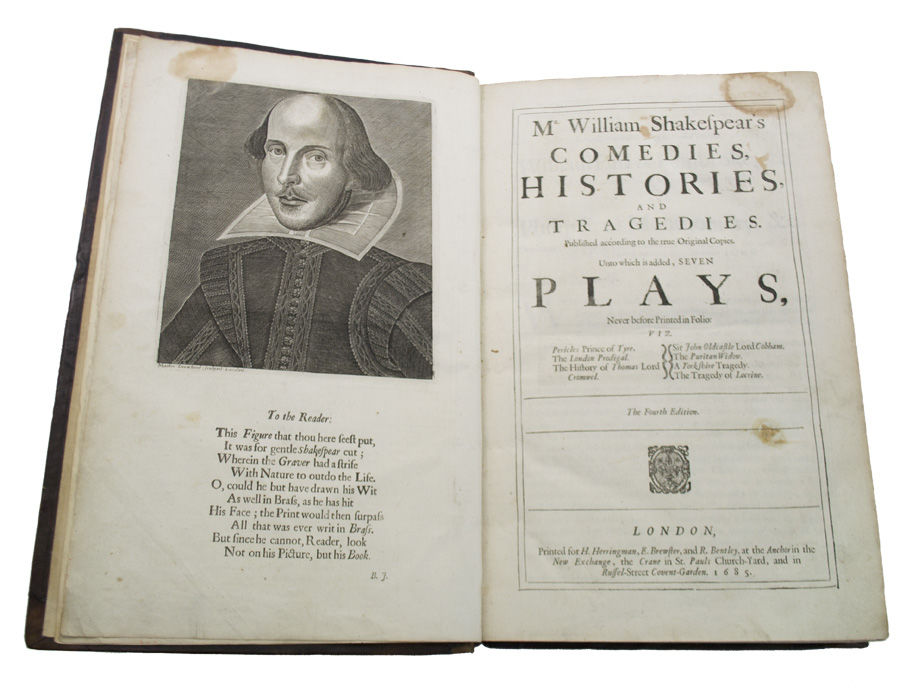Related Information
“A folio is a large book made by folding printed sheets of paper in half, with each sheet forming four pages. This format was usually reserved for history, religion, and other weighty subjects.” — Folger Shakespeare Library
What is the Most-Famous Folio?
The most-famous folio is likely the First Folio of Shakespeare, published in 1623 -- although a strong case can also be made for the Gutenberg Bible (c. 1455). Why has the First Folio gone down in history as the ne plus ultra of the antiquarian-book world? Before the First Folio, only about half of Shakespeare’s plays were available in book form, and these as smaller quartos, containing the text of one play each. The Folger Shakespeare Library succinctly details why this was sub-optimal for the preservation of the plays: “Quartos were like the easily disposable paperbacks of today, and relatively few of them survive. A folio was more expensive and sturdier, so it was more likely to last.” When you consider that 18 of Shakespeare’s plays may have been lost without their inclusion in the First Folio, you can see why it has become so revered.
According to the Folger Shakespeare Library, only 235 copies of the First Folio survive today — albeit some of these are damaged or incomplete. These are invaluable to scholars as some preserve variant lines and older speeches that were changed or omitted in other versions of the plays, and even in copies of the Folio printed later, as edits were often made in real time.
Visit the Folger Shakespeare Library for more information on the First Folio...
Featured item:
London: Printed for H. Herringman, E. Brewster, and R. Bentley, 1685. Incomparably The Most Important Work In The English Language"
The Fourth Folio edition of Shakespeare's plays, first state of the imprint (without Chiswell's name). Tall copy. Large folio (14 1/2 x 9 1/4 inches; 368 x 233 mm). [12], 96, 99-160, 163-254, 243 [i.3. 253]-272, [1], [1, blank], 328, 303, [3, blank] pp. (page 33 is numbered 23, 107 is numbered 109, 109 is 111, 190 is 186, 191 is 187, 219 is 221, 246 is 234, 253 repeated is 243, and 67 is 76). Engraved frontispiece portrait of Shakespeare by Martin Droeshout, with ten-line poem by Ben Jonson, entitled "To the Reader," underneath. Woodcut printer's device on title-page (McKerrow 263). Decorative woodcut initials.
A large copy in contemporary full mottled calf, rebacked to style. With spine label, lettered in gilt. Boards stamped in blind. All edges speckled red. With quite generous margins. Small repaired closed tear on leaf F, barely affecting text. Occasional light soiling and a few small stains to title-page. A few tiny holes to leaves G2, affecting one letter and Cccc2 affecting two letters. A light dampstain to bottom outer corner of signature F. Previous owner's bookplate on front pastedown. Overall a beautiful copy of this important book. Housed in a custom 19th-century full morocco clamshell.
The Fourth Folio was the stateliest of all the folios, being printed on a Royal stock, distinctly larger than the sheets of the Third Folio, which in turn is on a larger sheet than the First and Second. The last edition of Shakespeare's plays printed in the seventeenth century and the last to be printed before the editorial endeavors of the eighteenth century.
First issue, without Richard Chiswell listed in the imprint, as he was listed on the second issue (the third issue lists Herringman alone). For this fourth edition Shakespeare's text was assigned to three different printers (one of whom has since been identified as Robert Roberts), who typeset their sections simultaneously, thus shortening the time it took to get to market. When the work was finished and the three sections of printed sheets collated, there was a shortage of 17 sheets from the second section (for the full press run), which were hastily reprinted without the characteristic borders around the text. Copies have been found with these second state sheets. In the copy offered here all of the sheets are in the original settings and with the borders.
A second anomaly distinguishes this edition: "The copy for this edition was divided among several shops. Some miscalculation apparently occurred so that the equivalent of about one column of additional matter had to be crowded into Sig L [pp. 123/124] which is therefore printed in a much smaller type than the rest of the volume" (Pforzheimer).
Although there is no accurate census of the number of folios still extant today, it is believed that copies of each printing number only in the hundreds. Shakespeare's portrait is in the fourth state, as issued, with verses below (see Blayney, 19).
The folios are "incomparably the most important work in the English language" (William A. Jackson). Because of their incalculable impact on the language, thought and literature of our world, they are among the most desirable of all English language books, the prizes of any collection.
Offered by Heritage Book Shop.
For more information or to purchase this item, click here…
“The significance of the folio format for publishing these plays was twofold. Firstly, it conferred some economic advantages in that it enabled large amounts of text to be printed while making efficient use of the expensive imported commodity of paper (in this way a modern telephone directory is a useful comparison, making use of a larger format to present a lot of information in the most efficient possible way). But more significantly, it also had status implications. The folio format represented a different kind of publication, one associated with more high-status religious, topographical or historical contents than with the down-market products of the London theatre (here we might think of an exhibition catalogue or photographic 'coffee table book as the modern folio equivalent). This was not the standard format for play publication, as the lawyer and anti-theatrical controversialist, William Prynne, noted in horror in 1632. For Prynne, that 'some play books are grown from Quarto into Folio had turned his enemies from 'pygmies' to 'giants", and he notes the specific referent for that 'some' in the margin: 'Shakespeare's plays are printed in the best crown paper, far better than most bibles.'"
-- Emma Smith, Shakespeare's First Folio: Four Centuries of an Iconic Book (Oxford University Press, 2018)
Modern Folios
Today some booksellers are providing the height of a book in inches or centimeters rather than using early terms, such as folio, which do not relate directly to the sheet size or process used for printing today. In modern terms, a folio refers to a book more than 13 inches tall.
Doubles, Elephants & Atlas Folios
Some early folios were quite large when compared to those produced in later centuries. Thus, a folio like the Gutenberg Bible (with a page height of approximately 17.5 inches) is much larger than Shakespeare's First Folio (with a page height of approximately 12.5 inches), leading to the occasional use of the term double folio to denote a particularly large folio. Other terms have evolved to describe particularly large-format books; although the exact dimensions of these terms varies, some sources define an elephant folio as having a page height of 23"-25", an altas folio pages above 25", and a double elephant folio above 50".
The most-famous "elephant" folio is John James Aubudon's Birds of America double elephant folio project, which was a four-volume set of Audubon's Birds of America printed on the largest paper available at the time, and published between 1827 and 1838. According to the Friends of Audubon, the four volume set "contains 435 hand-colored engravings of 1,065 birds that supposedly represent all known species in the United States at the time. Audubon wanted to show the birds at life size, so he selected to use “double elephant” size paper (approximately 26 1/4 x 39 1/2 inches, the largest sheets available then). This edition is commonly known as the Double Elephant Folio due to the size of the paper chosen for the publication." About 190 sets of these elephant folios were printed, but many were broken up so the prints could be resold individually. Friends of Audubon estimate that only about 120 sets remain complete.
Naturally, once the phase "elephant folio" had entered the lexicon, it was only a matter of time before the cutsy baby elephant arrived! But, here we have left the technical world of book cataloguing and entered the evocative realm of marketing. As you can see from the book description below, the page height of the Audubon "Baby Elephant Folio" is 15 inches, bringing us back full circle to the modern definition of a folio as simply a book more than 13 inches tall.
Featured item:
Audubon's Birds of America The National Audubon Society Baby Elephant Folio
by PETERSON, ROGER TORY AND VIRGINIA MARIE PETERSON (EDITORS)

New York: Abbeville Press Publishers, 1990 (1981). Third Printing of the Revised Edition. Fine in whit linen covered boards with black text and borders on the spine. In a fine, unclipped dust jacket. Both the book and its dust jacket are contained within a fine illustrated, paper covered slip case. A folio measuring 15" by 11 1/2". Unpaginated. Illustrated with 435 beautiful, full color plates followed by concordance index between this edition and Audubon's original edition, and a general index of bird names. Each plate is "captioned with each bird's currently accepted vernacular name, followed by Audubon's identification...." (from the preface). The plates are organized according to modern scientific classification rather than in the way Audubon originally organized the plates; hence, the need for the concordance index. The book contains a comprehensive survey by Peterson of the American bird artists who preceded Audubon and the many who followed him which includes numerous color examples of their art. A stunningly beautiful volume in pristine condition!
Offered by Town's End Books.
(Image sources: Heritage Book Shop; Town's End Books)

